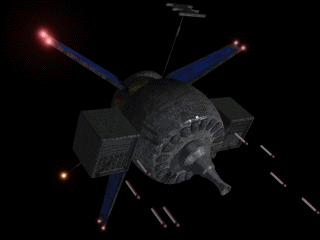
We've got you covered.
An Orbital Defense Network (also known as an Orbital Defense Grid) is a system of military satellites and battlestations responsible for defending a planet from spaceborne threats. In the age of interstellar warfare, an ODN is an essential element of any planet's infrastructure, whether that planet is a highly populated civilian colony, or merely a small military outpost. Furthermore, because targets on a planet's surface are so vulnerable to bombardment from space, "Capturing the Orbitals" is usually a vital first step in any plan for the military conquest of a planet.
Components[]
Most Orbital Defense Networks comprise primarily of two types of facilities. Platforms are unmanned satellites, and typically make up the bulk of any defense network. Most platforms are exclusively dedicated to either weapons or sensors, although some platforms will mount both (those fielded as part of smaller ODNs defending less critical real estate). Typical weapons for such platforms include Blackhawk Missiles, chemlasers, plasma cannons, and single-use bomb-pumped X-ray lasers.
The other primary component of a defense network are battlestations. Battlestations are manned satellites, usually both heavily armed and armored. These are the command and control centers for an Orbital Defense Network, and generally priority targets for an invading fleet.

A typical defense platform armed with 1-meter chemlaser and Blackhawk Missiles
Some Orbital Defense Networks also rely on surface facilities (though these might then be more properly referred to as Planetary Defense Networks). Humanity's earliest planetary defenses often relied on large numbers of surface-to-space missiles and vast ground-based sensor arrays. In most cases, such defenses are significantly less efficient than their spaceborne counterparts because of atmospheric interference and the extra thrust needed to escape a planet's gravity well. One notable exception: on planets with negligible atmosphere, ground-based lasers can be much more deadly to targets in space because of their ability to sink waste heat into the ground, while space-based lasers are limited by their ability to radiate heat away.
Defense Strategy[]
In modern strategy, dispersion is the key to an effective Orbital Defense Network. The most heavily fortified planets employ thousands of small, specialized defense platforms scattered in a globular, orbiting cloud. A dispersion strategy prevents an attacker from quickly degrading an ODN's total firepower by offering numerous targets, none of which comprise a significant portion of the network's total capabilities. An ODN designed along these lines can be fiendishly expensive, however. They require large, constantly roving maintenance teams to keep the many weapons and sensor platforms in working condition.
Networks defending less valuable targets tend to have smaller numbers of larger and more generalized defense platforms (sometimes with significant propulsion capabilities, effectively making them full drone warships, or even maned mini-warships like the LAC-1054). These are more cost-effective to deploy and maintain, but less capable of withstanding a dedicated attack.
Surface Warfare[]
With few exceptions, Orbital Defense Networks are optimized solely for the destruction of targets in space: whether these are hostile invasion fleets, pirates, or simply incoming asteroids or other hazardous materials. Despite the intent of their design, however, ODNs still represent a deadly menace to anyone or anything on a planet's surface which makes an enemy of the network's controllers. Weapons platforms may be "flipped" to target points on the surface for Kinetic Interdiction Strikes. Any ODN extensive enough to offer good defensive coverage of its planet's orbital neighborhood wields more than sufficient firepower to render that planet's surface uninhabitable to life. Only bunkers buried many kilometers below a planet's surface could ever be considered safe from orbital bombardment.
This threat is actually the reason populated planets have such extensive defense networks: to prevent an enemy from gaining control of the orbitals, which would allow them to easily bombard the helpless population centers below. Only the most fanatic or well-fortified planetary defenders would refuse to surrender to a hostile fleet in control of their planet's orbitals. However, actually carrying out such an attack would be only slightly less damaging to a planet's infrastructure and ecology than an old-style full scale nuclear exchange. Capturing a planet with its industrial and economic infrastructure intact is often far more valuable than capturing a cratered moonscape in the grip of an ice age.
So in intra-species civil wars, planetary bombardments are rare. The only major such incident in recent decades was Erich Von Shrakenberg's destruction of Earth in 2244, a planet that had not only held out against several ground assaults, but whose physical and biological infrastructure had already been devastated by the Bug Asteroid of 2198, so there were few intact cities worth saving, and only a small planetary population at risk. Even in inter-species wars, where much of one species' physical infrastructure of cities may be incompatible with the needs of their enemy, and where the planet's population is more an annoyance than a prize to be taken, the ecological and climatological consequences of a truly heavy bombardment are so costly in terms of future terraforming costs that large-scale bombardment of cities is equally rare. The major exception is the Bugs, who not only do not flinch from bombarding enemy planets when given the chance (they hit Earth three times, twice with city-killing asteroids and once with a huge one that started an ice age), but who are often the targets of bombardments themselves (such as when Viktor Molotok used mass drivers to destroy Bug Hive Ships that had landed on Deseret in 2265).